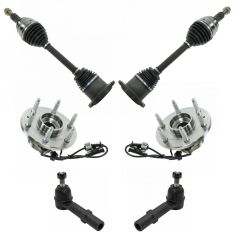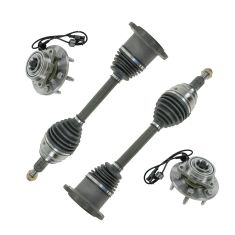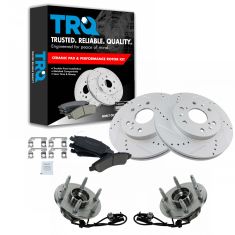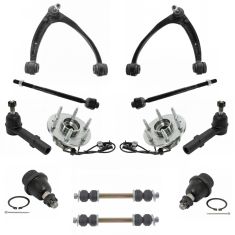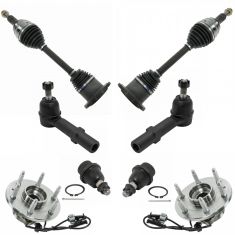Replaces
2011 GMC Yukon XL 1500 All Wheel Drive with Cast Iron Lower Control Arms without Aluminum Steering Knuckles Front 6 Piece Suspension & Drivetrain Kit TRQ PSA44164
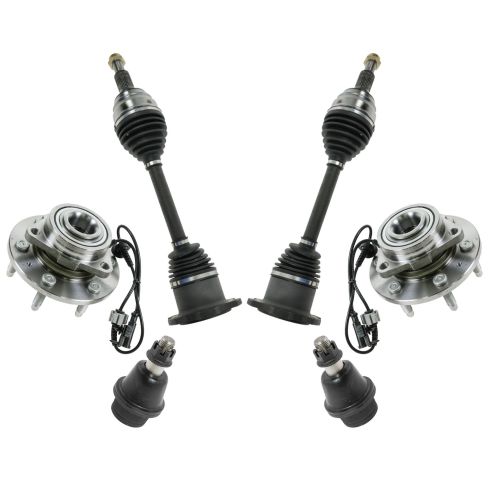

PSA44164
In Stock
This part doesn’t fit a . Select from parts that fit.
Specify your vehicle's year, make and model to guarantee fit.
Orders must be placed by 2pm ET
Part Details
- Quantity: 6 Piece
-
Kit Includes:
(2) Front Lower Ball Joints
(2) Front CV Axle Assemblies
(2) Front Wheel Bearing & Hub Assemblies
Specification
- All Wheel Drive
- without Aluminum Steering Knuckles
- with Cast Iron Lower Control Arms
- Front
Product Features
TRQ drivetrain kits are manufactured using premium raw materials to restore original performance. Each TRQ drivetrain component is designed to be a direct, maintenance-free replacement to the stock unit. To extend the service life of your drivetrain, TRQ recommends replacing wheel hubs, bearings, and constant velocity (CV) drive axles at the same time to ensure even wear of components and improved ride comfort. All products are fit and road-tested in our Massachusetts R&D facility to ensure we deliver on our promise of Trusted Reliable Quality.
Our steering and suspension components are pre-greased and sealed for long life and do not require the extra maintenance typically required by greaseable versions.
Item Condition:
New
Attention California Customers:
![]() WARNING: This product can expose you to chemicals including Lead and Lead Compounds, which are known to the State of California to cause cancer, and birth defects or other reproductive harm. For more information, go to www.P65Warnings.ca.gov.
WARNING: This product can expose you to chemicals including Lead and Lead Compounds, which are known to the State of California to cause cancer, and birth defects or other reproductive harm. For more information, go to www.P65Warnings.ca.gov.
Lifetime Warranty
This item is backed by our limited lifetime warranty. In the event that this item should fail due to manufacturing defects during intended use, we will replace the part free of charge. This warranty covers the cost of the part only.





Created on:
Tools used
First, we're gonna take the center cap off. I'm gonna use a pry bar. If you don't wanna scratch the wheel, just use a rag. Wrap the pry bar around the rag and slide it out. Use a 22-millimeter socket to take the lug nuts off. Take the wheel off. I'm gonna take the brake caliper off with the bracket. I'm gonna use an 18-millimeter socket and take these bracket bolts out.
Slide this out. Use a brake caliper hanger. There you go. Make sure there's no tension on the brake hose. Now, I'm gonna take the screw out. I'm gonna use a T30 socket. Grab the rotor and slide it off. Take this nut off, use a 36-millimeter socket. And take the washer off. And just make sure that the axle is loose from the hub. You can tap that with a hammer. You should use a punch so that you don't ruin the splines on the axle.
Now, I'm gonna take this ABS harness off of here and use a trim tool, just get underneath here. Disconnect it here. There's a little retainer right there. You can use a pocket screwdriver. There we go. And just push it down, disconnect it. Then you can do the same right here. Slide that up. And then there's another retainer right here, and then just pry it out just like that. If you can squeeze those tabs with some needle-nose pliers, that works too. And that harness is good right there.
Now, the housing of the hub has three holes that are bolted on, so you need to take those bolts out. Those are on the backside of the knuckle. I'm gonna take these bolts out. I'm gonna use a 15-millimeter socket. And there's another one right here. Take those out. Okay. Then just grab the hub and slide it out. And if it doesn't come out that easy, you can take a hammer and just tap it from the backside or even a slide hammer and take the shield off. I'm just gonna take a wire brush to just clean up some of the rust and just use a little anti-seize so it doesn't seize up in there, doesn't rust up in there. Just use a little thin coat on the surface.
And take the dust shield. Make sure you have the ABS wire go through the dust shield first. Line that up and slide it in position. And take the three bolts and get those started. And then I'll take a torque wrench and torque these bolts to 133-foot pounds. There we go. Put the washer back on, put the nut on. Then tighten up the nut and torque it.
I'm gonna use a pry bar in between the lugs to prevent the hub from spinning and torque this nut to 177-foot pounds. It'll check that. There we go. And take the wiring harness and put this back in position, lock it in place. Looks good. Reconnect the connector and push down on the lock and push back in place. Looks good. Just take a little anti-seize and just put a thin coat on just to prevent future rust.
Take the rotor, line it up. Line the hole up with the threaded hole and put the screw in, and just snug it up. It's good. And take the caliper and slide it off the hanger, and slide it over the rotor. Take the bolts. You can put some thread-locking compound on the bolts and get these started. I'm gonna tighten these bolts to 148-foot pounds. Put the wheel back on and the lug nuts.
Now, I'm gonna torque these lug nuts to 140-foot pounds. I'm gonna do it in a cross pattern so it tightens the wheel down evenly. And I'll just go around again and double-check. You're good. Center cap, put it back on. Because we pulled the caliper off, there's gonna be a little air gap between the rotor and the brake pads so just pump the brakes. Make sure you get rid of that air gap and you should be good to go.
Tools used
Tools used
Tools used
One of the first things you want to do is safely raise and support your vehicle by the frame so your suspension can hang. Once you've done that, take a small pry bar, and we're going to take off this center cap. If you were to spin it, you're going to see a little notch in the cap. Carefully slide this off of here. That exposes our 22-millimeter lug nuts. Remove all six. Remove your wheel. Now, let's remove our 21-millimeter nut. Let's just put that nut on just a couple threads. Now, we're going to take a hammer and we're going to hit right here on the knuckle. You want to be very careful for your brake rotor.
Now that the wheel's off, we have a clear view of where we're going to start working. We're going to disconnect the electrical. This is the ABS right here, and it's very delicate. I'm just going to come right up along here and you're going to see where it's supposed to be mounted to the frame. Should be pretty secure. This is missing about half of its clip, so I'll make sure I secure it in afterward. This purple right here is a little lock. It's holding it from coming separated. I like to just come right in between here, pop that up. Now, we'll separate this. Just take a peek. Make sure you don't see any funny colors. If you were to come right down along here, we're going to get this clip off of here as well. Just give it a little twist, lift it up, grab that ABS wire, carefully set it aside. The next thing we're going to do is remove this 10-millimeter headed bolt. The next thing we're going to do is remove the nut that holds the upper ball joint to the knuckle. Okay. That comes right off. I'm just going to go ahead and put it on there just a couple threads for now. Now, let's use a 36-millimeter socket to remove our axle nut. Behind there, there's a washer. Go ahead and remove that as well. Let's go ahead and blast this with some penetrant. The next thing we need to do is separate the axle from the bearing. I'm going to use this punch right here and go right in the center. You definitely don't want to use a hammer and potentially damage the threads.
The next thing we need to do is remove our mounting bolts that hold the caliper to the knuckle. Use an 18-millimeter. Carefully hang your caliper so it's putting no pressure on your flex hoses. So, now, let's just double-check to make sure this upper ball joint nut is still on there a few good threads. It hasn't loosened up on us. And then we'll move down here to the lower ball joint nut. Remove that as well. Take that and just put it on a couple threads. Okay. So, now, it's going to be time to separate the upper ball joint from the knuckle right here. Pay special attention to anything that's delicate that you don't want ruined, such as an ABS wire. Make sure that that's secure and safely out of the way. Go ahead and take your nice little hammer, and we're going to bonk right here on the knuckle itself. As you can tell, it's separated. We can move along. So, now, let's pushed down on this. Remove that nut. And carefully draw this down. Now, if you're worried the knuckle with the rotor is going to be too heavy, you can go ahead and use a Torx bit right here, remove that bolt, and take the rotor right off. The problem with removing it like that is you're going to have to clean up the mating surface between the wheel bearing and the rotor itself. So, now, I'm going to take my hammer again and I'm going to come right down here and we're going to hit right on the knuckle itself until this comes down. There we are. Carefully lift up. Remove the ball joint nut. Carefully lower this down. Remove your knuckle.
The next thing we're going to do is remove the bolts that hold the axle to the front differential. That's what the bolts look like. Remove them all. The next thing that we're going to have to do is remove the sway bar link. And you're going to have to do that on both sides of the vehicle. The reason for that is because we want to take the sway bar and swing it down.
There we are, friends. Now, it's going to be time for the install. Take your axle, slide it right in here. Gonna take one of my bolts. I like to use some red threadlocker. We'll call it your prerogative. Go ahead and start in the bolts. Don't tighten any of them down completely until you've started them all in. Okay. Let's snug them up. Like to go criss-cross. All right. Just double-check them all.
Now, it's gonna be time to install your sway bar link. To do that, you want to make sure you have the shaft facing up like this with one of your washers, a bushing with a little piton facing up towards the control arm. I'm going to put it through the lower control arm. Put another bushing with the piton facing down towards the control arm. Nice metal washer. Gonna put my spacer, another metal washer, another rubber bushing with the piton facing up towards the sway bar, just like this. Go ahead and pull this down. Rubber bushing with the piton facing the control arm or the sway bar, washer, and then the nut. Start in the other side the same way. So, now, we're just going to tighten this up. It's important to remember that you don't need to flatten out your bushings. You just kind of want to make them so they're completely touching up against the sway bar and completely touching the control arm itself. I can see it's touching. This can't move around. And I have approximately the width of my pinky. Do the same to the other side of the vehicle.
Let's just take some copper never-seize and go right along this splined area. You don't necessarily need to go down the threaded area though. Go ahead and take your knuckle. I'm going to start it on the axle a little bit and slide it over the lower ball joint stud. Lift it up, kink it to the side, and start on that lower ball joint nut. Wiggle the axle around. Should slide right in. Now, we're gonna use a bar. We're gonna pull this upper ball joint down into here. Get the nut, go ahead and start it on there. Just gonna take my bar and try to hold pressure on the lower ball joint to the knuckle. And then we're going to go ahead and try to tighten it up. So, now, you'd want to torque this to 37 foot-pounds. If for some reason you can't get your torque wrench in there like I can't, I would just continue with my wrench and make sure it's nice and tight. Beep. Perfect. Now, it's time to torque up that lower ball joint nut as well, torque it to 37 foot-pounds. Now what we want to do is make sure that our slot is lined up with the hole that goes through the ball joint stud so we can make sure we install our cotter pin. Go ahead and slide that through. If for some reason yours is not lined up when you torqued it, you need to continue tightening, not loosening, until it's lined up with the next available slot. Go ahead and peen that over and lock it in.
All right. So, now, it's gonna be time to get the caliper on here. Just go ahead and slide it right over the rotor. Now, we're going to line up those bolt holes. I like to use some red threadlocker on these bolts. Start them in there. Okay. Let's bottom them out. Now, let's go ahead and torque these to 148 foot-pounds. Now, we'll just go ahead and take that tie rod end, put it right through the knuckle. Take your nut, start it on there. We're going to bottom it out. Now, you're going to torque this to 44 foot-pounds. That's torqued. The next thing we're going to do is look to see if we can find the hole in the stud of the tie rod and match it with the next corresponding slot on the tie rod stud nut. This doesn't line up. So, what I need to do now is I need to continue tightening until it does. I can see right through. I'm going to grab that locking cotter pin and install it. Slide that right on through and just peen it over. There's no way that this nut can come loose. Now, it's going to be time to get the washer with the axle nut on there. Go ahead and slide the pair on. Go ahead and use your 36-millimeter socket, bottom it out, and then we'll torque it. Just going to put a little splash of never-seize in here. I've got my mounting bolt. Let's use our 10-millimeter and snug it up. Make sure it's fully secured. Make sure there's nothing binding your flex hose for your brakes are not twisted in any way.
Now, it's time to get our ABS wire resecured. Let's go ahead and put it in right here. Make sure it cannot come loose. If this can hang around and move around, it could potentially get damaged. We'll go ahead and connect this in now. Listen for a click. Give it a tug. Go ahead and slide in your lock. Now, we're going to take our mounting hardware here and just slide it right down and in. It's just a little push clip. Give it a nice tug. Make sure it's definitely secured.
So, of course, next, you'd want to go ahead and torque down this nut right here. And that's going to be torqued to 177 foot-pounds. You can do that several ways. If you were to just do it like this, what you're going to notice is it just keeps spinning. If that was the case, what you would do is you can use a pry bar coming straight through these lug studs like this down to the ground and so it holds it from spinning on you and then you would torque it. If you didn't want to go through the process doing that, you can go ahead and throw the wheel up on there and then go through the center hole, which is the way that I'm going to do it. We'll grab those lug nuts. Start them all on there. Let's bottom these out.
Now, we'll bring it down to the ground and we'll make it so the wheel is just barely touching enough so the wheel can't spin. It's time to torque down this axle nut, 177 foot-pounds like I said. Torqued. Now, let's do the lug nuts, 140 foot-pounds. Go criss-cross. Torqued. Now, it's going to be time to get the center cover on. Before you go ahead and pound it on there, just take a look at the back. You're going to see something that looks a lot like a valve stem, line it up. This can go pretty much just like this. Light bonk. And then, of course, clean up your wheel, make it look nice and pretty, and take it for a road test.
Tools used
One of the first things you want to do is safely raise and support your vehicle by the frame so your suspension can hang. Once you've done that, take a small pry bar and we're going to take off this center cap. If you were to spin it, you're going to see a little notch in the cap. Just carefully slide this off of here. That exposes our 22-millimeter lug nuts. Remove all six. Remove your wheel. Now let's remove our 21-millimeter nut. Let's just put that nut on, just a couple threads. Now we're going to take a hammer and we're going to hit right here on the knuckle. You want to be very careful for your brake rotor.
Now that the wheel is off, we have a clear view of where we're going to start working. We're going to disconnect the electrical, this is the ABS right here, and it's very delicate. I'm just gonna come right up along here, and you're gonna see where it's supposed to be mounted to the frame. Should be pretty secure. This is missing about half of its clip, so I'll make sure I secure it in afterward. This purple right here is a little lock, it's holding it from coming separated. I like to just come right in between here, pop that up. Now we'll separate this, just take a peek, make sure you don't see any funny colors. If you were to come right down along here, we're gonna get this clip off of here as well. Just give it a little twist, lift it up, grab that ABS wire, carefully set it aside. The next thing we're going to do is remove this 10-millimeter headed bolt. The next thing we're gonna do is remove the nut that holds the upper ball joint to the knuckle. Okay. That comes right off. I'm just gonna go ahead and put it on there just a couple threads for now. Now let's use a 36-millimeter socket to remove our axle nut. Behind there, there's a washer. Go ahead and remove that as well. Let's go ahead and blast this with some penetrant.
The next thing we need to do is separate the axle from the bearing. I'm going to use this punch right here and go right in the center. You definitely don't wanna use a hammer and potentially damage the threads. The next thing we need to do is remove our mounting bolts that hold the caliper to the knuckle, use an 18-millimeter. Carefully hang your caliper, so it's putting no pressure on your flex hoses. So, now let's just double-check to make sure this upper ball joint nut is still on there a few good threads, it hasn't loosened upon us. And then we'll move down here to the lower ball joint nut. Remove that as well. Take that, and just put it on a couple threads.
Okay, so now it's gonna be time to separate the upper ball joint from the knuckle right here. Pay special attention to anything that's delicate that you don't want ruined, such as an ABS wire. Make sure that that's secure and safely out of the way. Go ahead and take your nice little hammer. And we're going to bonk right here on the knuckle itself. As you can tell it's separated, we can move along. So, now let's push down on this. Remove that nut. And carefully draw this down. Now if you're worried the knuckle with a rotor is going to be too heavy, you can go ahead and use a Torx bit right here, remove that bolt, and take the rotor right off. The problem with removing it like that is you're gonna have to clean up the mating surface between the wheel bearing and the rotor itself. So, now I'm going to take my hammer again and I'm going to come right down here and we're going to hit right on the knuckle itself until this comes down. There we are. Carefully lift up, remove the ball joint nut. Carefully lower this down, remove your knuckle.
The next thing you're going to want to do is support your lower control arm so that you're not putting maximum pressure on your front shock/strut. If you are, you can potentially damage it, because we're going to be using a hammer and we're going to hit right here on the lower ball joint to break it free.
Now to install the lower ball joint, we're gonna want to take the boot off of it first. So, I'm just going to use a nice small screwdriver, pry bar, weasel it in between. Then just kind of separate the two. Be careful not to damage the boot, of course, because we're going to be using it. The next thing we need is a ball joint kit with a cup that's going to fit right up against this lip. We're going to come right underneath, and then we're going to press this right up and in. Right along the bottom. I'm going to use a cup that looks like this, with a hole in the bottom, that's for the stud to go through. It's going to press right up against this ridge right here. Take this cup, something that's hollow enough to make sure that the top part of the ball joint can fit inside. Put it right over the top. Now we're going to take our ball joint C-clamp, put it right over the top, bottom it out. Just check to make sure that the cup is centered to approximately where the ball joints going to be.
Now we're going to tighten this up. As we do that, we want to check this ridge and make sure it matches up directly along this control arm. As you can tell, the ball joint ridge is directly against the control arm right here. Before I release any pressure, I'm just going to give the control arm a couple light bonks with my hammer, just for a little bit of vibration to help make sure this is seated securely. That should be pretty great. Carefully remove your tool. Make sure you install your clamp. To do that, just use these little pliers right here. They fit inside the holes, and then you can spread it. Slide it right over. Make sure it's sitting inside the roof all the way around. If it isn't, just work at it until it is. Now we're going to install our boot. Just carefully bring it up here. I like to try to start it on one side, so I'll go on the side farthest away from me. Then I'll use some pliers and just kind of roll the lip right on. Obviously, be careful not to poke any holes in the boot. Inspect it for any damage. Make sure that it's completely secured. This looks perfect.
Go ahead and take your knuckle. I'm going to start it on the axle a little bit, then slide it over the lower ball joint stud. Lift it up. Kink it to the side and start on that lower ball joint nut. Wiggle the axle around. Should slide right in. Now we're going to use a bar, we're going to pull this upper ball joint down into here. Get the nut, go ahead and start it on there. Just going to take my bar, and try to hold pressure on the lower ball joint to the knuckle. And then we're going to go ahead and try to tighten it up. So, now you'd want to torque this to 37-foot-pounds. If for some reason you can't get your torque wrench in there, like I can't, I would just continue with my wrench and make sure it's nice and tight. [vocalization]. Perfect.
Now it's time to torque up that lower ball joint nut as well. Torque it to 37-foot-pounds. Now what we want to do is make sure that our slot is lined up with the hole that goes through the ball joint stud, so we can make sure we install our cotter pin. Go ahead and slide that through. If for some reason yours is not lined up when you torqued it, you need to continue tightening, not loosening, until it's lined up with the next available slot. Go ahead and peen that over and lock it in. All right. So, now it's gonna be time to get the caliper on here. Just go ahead and slide it right over the rotor. Now we're gonna line up those bolt holes. I like to use some red threadlocker on these bolts. And start them in there. Okay. Let's bottom them out. Now let's go ahead and torque these 248-foot-pounds. Now we'll just go ahead and take that tie rod end, put right through the knuckle. Take your nut, start it on there. We're gonna bottom it out. Now you're gonna torque this to 44-foot-pounds. That's torqued.
The next thing we're gonna do is look to see if we can find the hole in the stud of the tie rod and match it with the next corresponding slot on the tie rod stud nut. This doesn't line up, so what I need to do now is I need to continue tightening until it does. I can see right through. I'm going to grab that locking cotter pin and install it. Slide that right on through and just peen it over. There's no way that this nut can come loose. Now it's going to be time to get the washer with the axle nut on there. Go ahead and slide the pair on. Go ahead and use your 36-millimeter socket, bottom it out, and then we'll torque it. Just gonna put a little splash of never-seize in here, I've got my mounting bolt. Let's use our 10-millimeter and snug it up. Make sure it's fully secured, make sure there's nothing binding your flex hose for your brakes are not twisted in any way.
Now it's time to get our ABS wire re-secured. Let's go ahead and put it in right here. Make sure it cannot come loose. If this can hang around and move around, it could potentially get damaged. Go ahead and connect this in now. Listen for a click, give it a tug. Go ahead and slide in your lock. Now we're going to take our mounting hardware here and just slide it right down in there. It's just a little push clip. Give it a nice tug, make sure it's definitely secured.
So, of course, next, you'd want to go ahead and torque down this nut right here. And that's going to be torqued to 177-foot-pounds. You can do that several ways. If you were to just do it like this, what you're going to notice is it just keeps spinning. If that was the case, what you would do is you can use a pry bar coming straight through these lug studs like this down to the ground. And so it holds it from spinning on you and then you would torque it. If you didn't want to go through the process doing that you can go ahead and throw the wheel up on there and then go through the center hole, which is the way that I'm going to do it.
We'll grab those lug nuts, start them all on there. Let's bottom these out. Now we'll bring it down to the ground and we'll make it so the wheel is just barely touching enough so the wheel can't spin. It's time to torque down this axle nut, 177-foot pounds like I said. Torqued. Now let's do the lug nuts,140-foot-pounds. Go crisscross. Torqued. Now it's gonna be time to get the center cover on. Before you go ahead and pound it on there, just take a look at the back, you're going to see something that looks a lot like a valve stem. Line it up. It's gonna go pretty much just like this. Light bonk, and then, of course, clean up your wheel, make it look nice and pretty and take it for a road test.

PSA44164
In Stock
Product Reviews
877-844-3393
Monday - Friday 8:00am - 9:30pm ET
Saturday - Sunday 8:00am - 4:30pm ET
Specify your vehicle's year, make and model to guarantee fit.
This part doesn’t fit a . Select from parts that fit.














